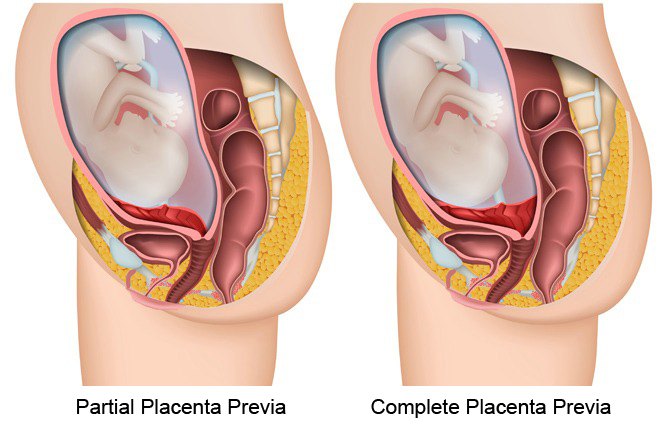When you think about it, pregnancy is amazing; it’s a miracle how your body was formed in order to support the life that’s growing inside you. In this process, there’s an organ that is vital in making sure your baby gets the nutrients he needs to survive from beginning to end – the placenta. This article is all about the placenta. Its role in pregnancy and when you should be concerned that not all is well with the placenta, warranting medical attention.
What is the placenta in pregnancy?
It is an organ specially grown in your uterus during pregnancy to support your developing baby. It is the starting point of your baby’s umbilical cord. And it grows as your baby grows and as the number of amniotic fluid increases.
Placenta in pregnancy
Again, an organ that grows in the uterus during pregnancy is called the placenta. A developing newborn receives oxygen and nutrients from this structure. It also cleans the baby’s blood of waste materials. The baby’s umbilical cord grows from it, which is attached to the uterine wall throughout pregnancy. Typically, the organ is affixed to the uterus’s front, rear, side, or top. Rarely, the structure may connect in the uterine cavity below. This situation is known as a low-lying placenta or placenta previa.
What is placenta in pregnancy?
It is made up of the same cells as your baby and attaches itself to the wall of your uterus, usually at the top or side.
According to Cleveland Clinic, when the fertilized egg implants into your uterine wall, the placenta starts to develop. The majority of the blood arteries in it are housed in “villi,” or tubular structures, and they attach to the baby’s circulation via the umbilical cord. The remaining placental tissues mostly function as a conduit between the villi and the umbilical cord and a passageway for your blood to bathe the villi, supplying the baby with oxygen and nutrition.
When does the placenta form in pregnancy?
According to Cleveland Clinic, it starts to form after a fertilized egg implants in your uterus around seven to 10 days after conception. It starts as a few cells and grows to several inches as your pregnancy progresses.
When does the placenta take over?
After the first trimester, around weeks 8 to 12, it takes over key functions such as hormone production and providing nutrients to your baby. Around this time, pregnancy symptoms such as nausea and morning sickness also diminish.
However, in this context, the placenta “taking over” means that what you consume can now reach your baby via the umbilical cord and placenta. Your own hormone production and nutrition are vital during this stage.
After your baby is born, your placenta — which by now is around the size of a dinner plate — is also delivered. Some women opt to consume it in the form of specially made pills. You can read all about placenta encapsulation and what it involves by following this link.

Some women choose to consume their placenta for health benefits, via a process known as placenta encapsulation.
According to the Cleveland Clinic, some people believe that eating or consuming placentas has health benefits. Aside from consuming it in the form of specially made pills, it can be cooked and swallowed.
However, there are not enough studies that prove eating or consuming placentas offers health benefits. Consult your doctor first before you decide whether to take cooked placentas or encapsulate and swallow it like a vitamin.
Other people throw it away after giving birth. But some people opt to bank placental tissue through a stem cell bank. The placental tissue and blood are collected and stored. If you and your baby have an illness, or your baby is born premature or too small, your doctor might recommend examining your placenta.
Types of placenta in pregnancy: Position
There are different types of placenta in pregnancy depending on where they formed in your uterus. The placenta develops in the side of your uterus where the fertilized egg was implanted.
Four of the most common position or types of the placentas are posterior, anterior, fundal, and lateral placenta.
It is called posterior placenta if the placenta grows on the back wall of the uterus. When the placenta grows on the front wall of the uterus near the abdomen, then it is called the anterior placenta.
Moreover, when the placenta grows at the top of the uterus, it is called the fundal placenta. Lastly, it is called lateral placenta if the placenta grows on the right or left wall of the uterus.
Placenta function: What does the placenta do?
It plays a vital role in pregnancy. There are lots of placental benefits that your baby can get. Understanding the function and benefits of the placentas in pregnancy is important.
Placenta function and benefits
Your growing baby gets all the oxygen and nutrients they need via placentas, throughout the duration of your pregnancy.
This happens because the placenta links your blood supply with your baby. Transferring everything they need to grow and develop, directly to them. In fact, experts point out that during every minute of pregnancy, “around 550 milliliters of blood is pumped into the uterus to exchange enough nutrients placentas for your baby.”
This is also why pregnant moms need to be careful about what they eat and drink during pregnancy, as well as the drugs they take, as these pass directly to their growing baby.
The placenta also produces hormones that help to trigger labor. But until the time is right for your baby’s birth, this organ secretes hormones such as progesterone and estrogen to prevent early labor.
This incredible organ also removes waste products from your baby’s blood to yours, which your body disposes of. At the same time, it keeps your baby’s and your blood separate, almost acting like a filter, which helps to protect your baby from infections and harmful substances.
According to the UK’s National Health Service (NHS), towards the end of your pregnancy, “the placenta passes antibodies from you to your baby, giving them immunity for about three months after birth.”
This organ also works almost like padding to cushion your baby. While within your womb and provides your little one with the perfect, unique environment to thrive and grow.
This organ is delivered right after your baby is born. It usually takes five to 30 minutes to deliver after the baby is born. This part of the delivery is called afterbirth or the third stage of labor.
It is normal for your uterus to continuously contract when the baby is born until this organ is expelled from your uterus if you had a vaginal delivery.
For those who delivered their baby via Cesarean section, this organ is removed after the baby is delivered. Your healthcare provider will be the one to take it out of your uterus through the incision they made to deliver the baby.
Placental health
There are various factors that affect the health of your placenta, according to the medical experts at Mayo Clinic. While there’s nothing much you can do to change some of these, other factors are modifiable.
- Maternal age: Pregnant women over the age of 40 are at a higher risk of placental problems.
- High blood pressure: Hypertension during pregnancy can have a negative effect on your placenta.
- Premature rupture of the membranes: If your baby’s amniotic sac (a fluid-filled membrane surrounding him or her) leaks or ruptures prematurely during pregnancy, your placenta can be affected.
- Substance abuse: Women who smoke or use drugs such as cocaine during pregnancy are at a higher risk of experiencing placental problems.
- Multiple pregnancy: Carrying twins or triplets (or more) may increase the likelihood of the mother experiencing issues with her placenta.
- Abdominal trauma: Some placental problems may arise if a pregnant mum suffers a blow to her stomach or other similar trauma.
- Blood-clotting disorders: If you have a medical condition that affects your blood’s clotting ability, you may be at a higher risk of suffering from placental health problems.

Smoking and taking illicit drugs during pregnancy can sharply increase the risk of placental health problems.
Common placental problems
Most of the time and in most pregnancies, placentas function just fine. But sometimes, placental problems can crop up, particularly in advanced pregnancy.
The following are the most commonly encountered medical issues or placental problems:
What it is:
This condition occurs as a result of the placenta partially or completely covering the cervix. Which is the womb’s opening. It usually is experienced in early pregnancy and sometimes corrects itself as the uterus grows.
Risk factors:
Smoking and drug use, getting pregnant after 35, being pregnant with multiples.
Health risks:
Placenta previa can cause severe bleeding during or after a baby’s birth, endangering the lives of both mum and baby. The birth process may be disrupted too since the cervix is fully or partially covered.
Signs and symptoms:
Sometimes there are no symptoms at all and the condition might be picked up by routine ultrasound. Other times, placenta previa is marked by painless vaginal bleeding.
Treatment:
If placenta previa is experienced in the first half of the pregnancy, it usually corrects itself. However, you will still be monitored carefully by your obstetrician for the duration of your pregnancy.
The amount of bleeding, whether it stops, the stage of your pregnancy, the placenta’s location, and the health of you and your unborn child all play a role in how this condition should be managed. Late in the third trimester, if placenta previa still exists, your doctor may advise a C-section.

Placenta previa can occur partially or fully
What it is:
Here, it peels away (partially or fully) from the womb’s inner wall, usually close to delivery, but sometimes as early as 20 weeks of pregnancy.
Risk factors:
Trauma to the abdomen, being older than 35, being pregnant with multiples, not having enough amniotic fluid, water breaking too early, uncontrolled high blood pressure, smoking, and using drugs (e.g. cocaine).
Health risks:
The baby can be starved of oxygen and nutrition, and the mom can experience bleeding and cramps. Placental abruption may also trigger premature birth.
Signs and symptoms:
Continuous or sudden stomach pain, bleeding from the vagina sometimes with discomfort and tenderness of the uterus.
Treatment:
If you are close to being full term and you have mild placental disruption, your doctor may suggest immediate delivery of your baby, either via induced labor or C-section. And, if you are diagnosed with this condition early on in your pregnancy, you will probably be monitored closely by your healthcare provider.
What it is:
After giving birth, the placenta typically separates from the uterine wall. When there is placenta accreta, the placenta is partially or completely still firmly attached to the uterus. When the placenta’s blood veins and other components grow too far into the uterine wall, this disease develops. Significant blood loss during birth may result from this.
Medical experts explain that this condition is a result of placental blood vessels growing too deeply into the wall of the uterus. Also, “more-aggressive forms of this problem can also occur if placentas invade the muscles of the uterus (placenta increta) or if placentas grow through the uterine wall (placenta percreta).”
Risk factors:
Previous uterine surgery or have had placenta previa.
Health risks:
Severe bleeding following vaginal birth or premature birth.
Signs and symptoms:
Heavy vaginal bleeding in the third trimester.
Treatment:
C-section delivery followed by surgical removal of the uterus (abdominal hysterectomy). More-aggressive forms of this problem can also occur if placentas invade the muscles of the uterus (placenta increta). Or if placentas grow through the uterine wall (placenta percreta).
4. Retained placenta
What it is:
Sometimes, placentas get trapped in the uterus after the birth of your baby, because of a partially closed cervix, or because it is still attached to the uterine wall.
A retained placenta can develop when the placenta is still connected to the uterine wall or when it becomes caught behind a partially closed cervix. A retained placenta can result in serious infection or life-threatening blood loss if left untreated.
Health risks:
Heavy bleeding (postpartum hemorrhage) may affect the health of the mother if not stopped.
Signs and symptoms:
No delivery of the placenta 30 to 60 minutes after the birth of your baby.
Treatment:
If you have not delivered your placentas within 30 to 60 minutes after the birth of your baby, your healthcare providers may give you an injection of syntometrine or syntocinon to make your uterus contract strongly, thus expelling the placenta. In some cases, doctors may manually remove the placenta (following numbing of the area).
Moms, while it’s unlikely that you will experience any problems with your placentas during your pregnancy. Do consult your doctor without delay if you experience:
- Vaginal bleeding
- Trauma to your abdomen
- Strong uterine contractions
- Severe back pain
Also, make sure you visit your healthcare provider regularly throughout your pregnancy. The earlier placental issues are diagnosed, the better the chance is of reducing complications both for you and your baby.
Things to remember to avoid placental problems
Vaginal bleeding is one of the most common symptoms of placental problems. That is why it is necessary to consult your doctor if you experience bleeding from your vagina. Other signs that you have problems with placentas are:
To keep your placentas healthy, it’s best to avoid drugs, alcohol, and nicotine. If you are smoking, it’s better to stop since tobacco smoking is linked not only to placental problems but also to different pregnancy problems. Drinking alcohol, using unprescribed medicines, and smoking cigarettes are not recommended while you are pregnant. It is essential to consult your doctor or healthcare provider before taking any medications.
Other things about placenta
What size placenta normally has?
This organ measures 10 inches in length and 1 inch in thickness in the middle. By the time your baby is delivered, it usually weighs about 1 pound and 16 ounces.
What color does the placenta have?
The side that is linked to your uterus and the side that is closest to your child are the two sides of the placenta, and it has different colors. The side that faces your baby is gray, whereas the side that is linked to your uterine wall has a dark reddish blue tint.
What shape does the placenta take?
According to Cleveland Clinic, at term, the placenta appears as a rough disc of tissue that is packed with blood veins and is dark crimson in color. The blood vessels dominate the mature placental tissue. Through the umbilical cord, they are connected to the infant, and they branch out across the placenta disc like the limbs of a tree.
The placenta moves, right?
In a way. Only because the uterus grows larger during pregnancy and as the fetus develops does the placenta appear to move. During your 20-week anatomy ultrasound, your healthcare professional will examine the placenta’s position to see if its position could lead to issues. By 32 weeks of pregnancy, the majority of placentas have moved to the top or side of the uterus.
Additional information written by Jobelle Macayan
Here at theAsianparent Philippines, it’s important for us to give information that is correct, significant, and timely. But this doesn’t serve as an alternative for medical advise or medical treatment. theAsianparent Philippines is not responsible to those that would choose to drink medicines based on information from our website. If you have any doubts, we recommend to consult your doctor for clearer information.